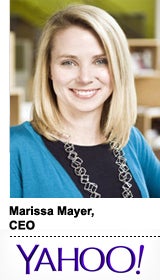 Yahoo CEO Marissa Mayer remained relatively unfazed onstage Tuesday at the Dreamforce conference as a pack of protesters disrupted an otherwise smooth Q&A session with Salesforce.com CEO Marc Benioff.
Yahoo CEO Marissa Mayer remained relatively unfazed onstage Tuesday at the Dreamforce conference as a pack of protesters disrupted an otherwise smooth Q&A session with Salesforce.com CEO Marc Benioff.
Despite the larger-than-life mural of Mayer’s mug and echoing shouts protesting her seat on Walmart’s board of directors, the fireside chat between the two CEOs covered territory about Mayer’s strategic vision for Yahoo, her stance on mobility and innovation and leadership in business.
Yahoo, which reported 800 million monthly unique visitors globally during its latest earnings report, continued its acquisition streak in Q3, picking up Bignoggins, Qwiki, Xobni, Admovate, Ztelic, Lexity, Rockmelt and IQ Engines. Although the company saw drops in its GAAP and display revenues, Yahoo says it’s in an experimental stage and Mayer offered Benioff some hints in their discussion.
On addressing a global audience
MAYER: In our industry, it’s always about designing for the global world. Bringing new product managers in and asking them to design products for the entire world is pretty daunting. I’m traveling and learning myself. We meet with users, advertisers, venture capitalists to see what is the pulse of technology in different regions of the world.
There are two things that bring value — all the product insights you get from sitting down with a user and seeing what motivates them to buy an iPad or a new laptop and what it really means to [see] how products do or do not translate in different markets.
On whether or not she “has a commitment to simplicity” in product
For me, it’s all about the user. You have to be a user of a product to understand what works, doesn’t work, why something takes too long to load and why different options get in the way. I don’t think you should design for the expert user. I think you should build products that are fast to learn. You can break it down to the core essence of what it’s trying to do for the end user. The core pathway and functionality through the product.
On Yahoo as a design-first organization
This is not how we think. We have an amazing design team at Yahoo. We have incredibly talented designers. We have a spot in my executive team as a “one-to-be-hired”: an SVP of design. I don’t get to spend a lot of my time on design. I’m not a designer by trade, but I do love design. Part of what I get to do is work with my team. [As CEO] you get to design the organization and the strategy.
On the mobile road map
We think of ourselves as mobile-first. It’s a wave large enough to ride to reinvention. Yahoo, like many companies, has to constantly reinvent itself. It happens with any platform shift. Salesforce.com rode the platform shift to cloud. Yahoo’s going to ride it to mobile. Voice, text, mail, maps, weather, stock quotes, games, sharing photos. We fulfill digital daily habits.
Mobile caught a lot of people by surprise. When you look at the history of Yahoo, it wasn’t clear how quickly [it should] make the move. Designing how mobile gets done within the company is hard. You think about questions like, “Should mobile engineers sit with the finance team?” It ends up being everyone’s hobby but nobody’s job. When I started at Yahoo, we had 30-60 [mobile engineers and we’ve grown that] to almost 400 year-over-year. We’re serious about developing mobile applications. We have almost 400 million monthly mobile users. I’m really proud of … our applications. We think the content services we have to offer suit themselves perfectly for this format.
About executing on ideas within Yahoo’s culture
There’s a huge number of people who have been with Yahoo forever. When I talked to Tony, [one of the first mobile engineers I met when I was hired], they said, “We know what the problems are, we just need someone to tell us ‘go.’” I didn’t see my plan as to lay out a 100-day plan. One of my other mentors, Eric Schmidt, said good executives confuse themselves when they convince themselves that they “do” things. Your job is to play defense.













